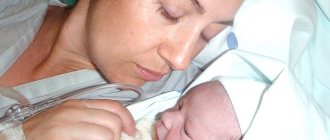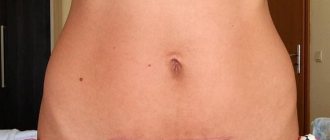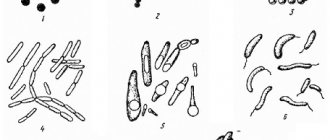Composition of lochia
How long do lochia last after childbirth, what is their composition, why do they have this color? Lochia consists of blood that oozes from the area on the uterine wall to which the placenta was attached during pregnancy, areas of the endometrium that have changed and thickened during pregnancy, blood, mucus from the cervix and dead tissue.
Blood enters the lochia mainly from a large area of the changed area that remains after the separation of the placenta. Bleeding from this area is controlled by contractions of the uterine muscles. The healing and restoration process of the endometrium takes about 2 weeks.
This is why the bleeding is maximum at first and then gradually decreases. All postpartum discharge occurs within 1.5 months after delivery.
Lochia is sterile for 2-3 days, but after that it is colonized by bacteria, emitting a typical odor, which is normal. The smell from normal lochia should not be confused with the smell of discharge if there is a postpartum infection.
How long do lochia last after childbirth, especially premature birth? The amount of discharge may be light after such a birth, but more than usual after a twin pregnancy or other conditions in which the uterus grows larger than in a normal pregnancy.
Lochia species
Depending on the color, lochia can be of three types:
1. Red lochia after childbirth. How long does this type of discharge last? They last for the first 4-5 days after birth and are red in color - hence the term. They consist mainly of blood, pieces of membranes, decidua, meconium and cervical mucosa.
2. After red lochia, serous ones appear. The initial discharge gradually changes color to brown and then turns yellow over about a week. Serous lochia contains fewer red blood cells, but more leukocytes, separated from the developing endometrium and mucus from the cervix.
3. Lochia alba, or white lochia, is a whitish, cloudy fluid that is discharged from the vagina for about 1-2 weeks. These secretions mainly consist of decidual cells, mucus, leukocytes and epithelial cells, cholesterol, and fat.
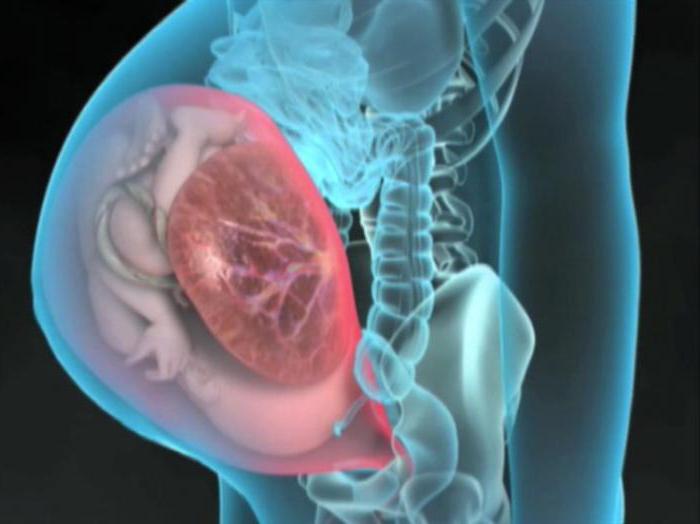
How long does lochia last after childbirth? The duration of this period can be from 4 to 8 weeks, but on average it is most often 42 days.
The number of lochia may vary. For some women, painful contractions of the uterus can lead to heavy bleeding with clots, which reduces the healing process.
Recommendations
Breastfeeding stimulates uterine contractions, which leads to an increase in the amount of lochia released. It is the irritation of the nipples and areola that promotes the release of internal oxytocin, which is necessary for contraction of the myometrium and involution of the uterus (restoration of its prenatal size).
Sometimes a sudden change in a woman's position, such as suddenly standing up or bending over, can lead to the release of large amounts of blood from the genital tract - this is simply drainage of the collected blood into the vagina and should not be a cause for concern.
However, it should be remembered that the endometrium, to which the placental tissue was attached, as well as some areas of the uterine mucosa are open for a long time, and bacteria can easily enter this wound surface from the vagina. Therefore, you should avoid using tampons. Sanitary pads are the best option for women after childbirth.
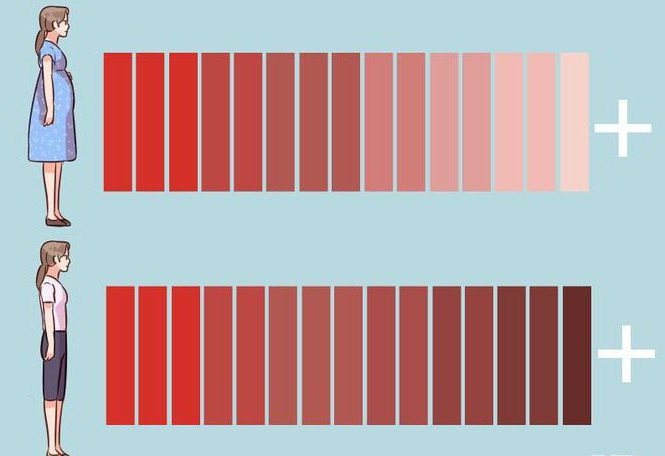
For the same reason, you should not have sex during the postpartum period to avoid infection, which is very dangerous for both mother and child.
It is also best to avoid swimming in public pools until the release of lochia has completely stopped.
In the postpartum period, the use of a shower is recommended. This will prevent infection from entering the uterus from the vagina, and will also promote better healing of the sutures after the episiotomy, if any.
First menstruation after childbirth
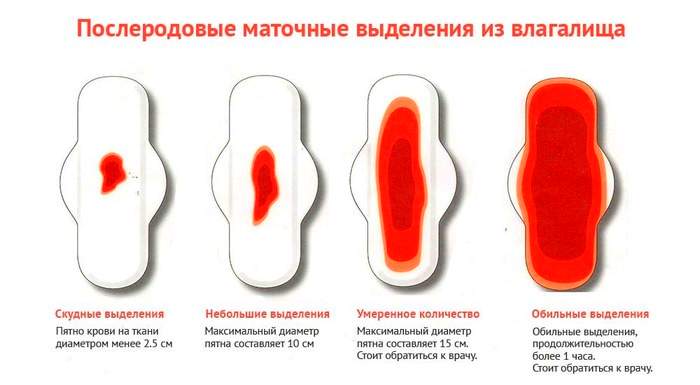
The first time after childbirth, the inside of the uterus is an extensive wound surface; in the place of the separated placenta, exposed vessels remain, actively bleeding, but gradually shrinking as the walls of the uterus contract and its mucous layer is restored. Therefore, in the postpartum period there will be discharge, initially bloody, but then gradually changing in nature to bloody and then serous . This is not menstruation in the full sense of the word, but the process of endometrial renewal is generally similar, but longer. Therefore, you should not expect your menstruation now on the same dates as it was before pregnancy. Typically after childbirth:
- Change in the nature of discharge,
- Change in their intensity (they can be more abundant and lasting)
- The duration of the cycle can vary either down or up,
- PMS and pain often disappear due to the equalization of hormonal levels
- Failures are likely if the birth had complications
- There may be pain and discomfort if there was an inflammatory process after childbirth that was not treated,
- Intermenstrual discharge is possible, especially against the background of the formation of placental polyps or other changes.
Important
In some cases, a consultation with a gynecologist is necessary if the nature of menstruation is greatly changed, there are delays and problems.
Pathological lochia
How long does lochia last after childbirth? What should their intensity be? What are the symptoms of the pathological process? Lochia may be abnormal if infection occurs during this time. An infection may be suspected if:
• lochia continues to remain bright red even after a week;
• The discharge suddenly turns bright red. This happens while they have already become pale;
• there is an unpleasant odor;
• all this is accompanied by fever with chills;
• pain in the lower abdomen increases significantly over time.
There is abnormally heavy bleeding that causes the pad to become wet in 1 hour or less, or there are a large number of clots. This is a sign of secondary postpartum hemorrhage and requires immediate attention.
How long do lochia last after childbirth?
The heaviest discharge occurs on the first day. Try not to panic if the bleeding seems to increase when you go home. Simply walking or running for a long time can increase blood flow. If the pad becomes completely wet within an hour, you should lie down and rest. If bleeding continues at the same rate for an hour or more, or if you observe larger clots, then it is extremely important to immediately consult a gynecologist, and if there is heavy bleeding, call an ambulance.
How long do lochia last after the second birth, should it really be shorter? Based on observations and reviews from mothers, after the second or subsequent births, the amount and duration of discharge does not change.
Other signs requiring medical attention:
• discharge remains red for more than 7 days after birth;
• there is an unpleasant putrid odor;
• you have symptoms of fever or chills.
When does your period start after childbirth?
The beginning of the period of childbirth depends, first of all, on the method of feeding the baby. Non-breastfeeding mothers note the appearance of the first menstruation already 1.5-2 months after the birth of the baby.
For breastfeeding women, the process is delayed. Sometimes menstruation after childbirth does not return during the entire period. Or, on the contrary, it begins approximately 2 months after the birth of the baby. But usually the first menstruation after childbirth comes 7-8 months after the birth of the child. And don’t look for any dirty tricks in your health here. Everything is individual.
The restoration of the menstrual cycle is associated with lactation and the hormone prolactin. It is what stimulates milk production and suppresses ovulation. And while the baby feeds exclusively on mother’s milk, prolactin “reigns” in the body. But as the amount of milk produced decreases, at this time the first menstruation begins after childbirth.
Even if your menstrual cycle has not yet fully recovered after childbirth, discuss contraception with your doctor. Ovulation begins before your period appears. Therefore, if you prefer a planned pregnancy, take care of this in advance.
Late postpartum bleeding
How long does lochia last after childbirth? Reviews from many young mothers confirm that this process takes no more than 1.5 months. Typically, vaginal discharge is pale pink or brown in color in the second week after birth. Don't be alarmed if you notice a bright red discharge that appears occasionally during the first 6-8 weeks. Exercise or increased activity can cause this phenomenon. To stop bleeding and reduce spasms, you need to lie down for a couple of hours. If this does not help, you need to contact an antenatal clinic.
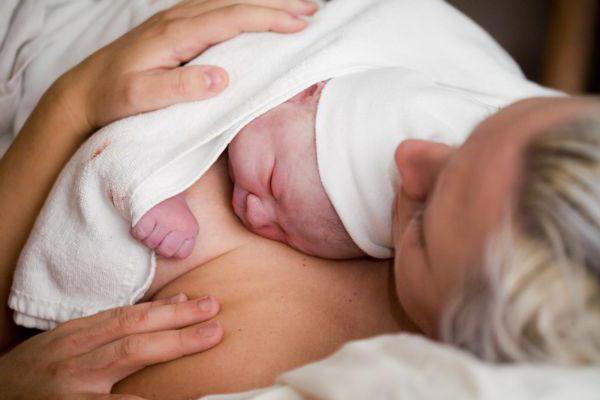
How long does lochia last after childbirth? How not to confuse them with bleeding? Postpartum hemorrhage is the most dangerous. If you lose no more than 600-700 ml of blood after an operative delivery or more than 300-400 ml after a vaginal birth, this is classified as normal blood loss. However, in 1 out of 10 cases out of the total number of all pregnancies there is a complication such as postpartum hemorrhage. It usually starts within 24 hours of birth (early postpartum hemorrhage), but it can occur at any time within 6 weeks - late postpartum hemorrhage. After childbirth, the most common cause is the inability of the uterus to contract properly, leading to uncontrolled bleeding from the place where the placenta was attached. Sometimes it can be the result of unsutured tears in the vagina or cervix. Late postpartum bleeding can occur as a result of incomplete detachment of placental fragments in the uterus or due to infection. Both of these types of bleeding are dangerous and can lead to the death of the mother.
Every woman preparing to become a mother needs to know how long lochia lasts after childbirth. Here are the characteristic signs of late postpartum hemorrhage:
• one pad is not enough for 1 hour;
• lochia does not change in color and intensity for more than 7 days;
• there are large blood clots of various sizes - the size of a golf ball or a lemon;
• pain or swelling in the abdomen during the first days after birth;
• Bleeding may cause loss of consciousness, shortness of breath, dizziness, or rapid heartbeat.
Menstruation after cesarean
After the lochia has ended and the woman’s body has recovered, menstruation begins after a cesarean section. This process is individual for each woman.
The following factors influence when your period comes:
- structural features of the body (age and course of pregnancy);
- way of life after childbirth (sleep, nutrition, etc.);
- infectious or inflammatory processes;
- stress and nervous disorders;
- breastfeeding period.
When do they start
It is worth noting that if after giving birth a woman prefers to feed the baby with her milk, then menstruation will occur after the completion of this process.
During breastfeeding, the female body produces the hormone prolactin, which blocks a woman's sex hormones. Because of this, the process of egg maturation does not occur, and menstruation does not begin.
As a woman reduces the number of feedings, the production of sex hormones increases and, accordingly, the likelihood of menstruation increases. As a rule, after stopping breastfeeding, the cycle should be restored within six months. With frequent feedings, you should not count on the restoration of menstruation.
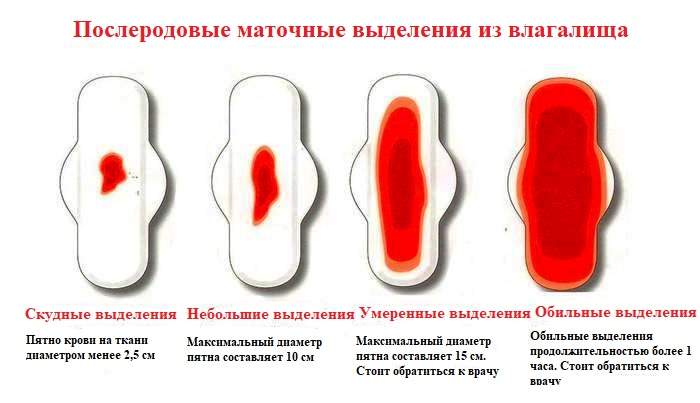
How long do they go?
How many days menstruation will last depends individually on the woman’s body. Some women note that after childbirth, the duration of menstruation decreased, and the number of days in the cycle also changed.
With breastfeeding and artificial feeding
Women who have had a cesarean section are interested in how long it takes for menstrual flow to come. As a rule, this happens after introducing the first complementary foods to the baby at 4-6 months.
If a child is fed only breast milk, then even after a cesarean section, menstruation may be absent for a year or more.
If a child eats ready-made formulas rather than mother's milk, then menstruation can occur as early as a month after birth, but no later than 8-12 weeks after birth.
If the cycle is irregular, and the nature of menstruation is constantly different, then you should definitely contact a gynecologist, as this may be caused by pathological processes in the body.
There is an opinion that if a woman had an irregular cycle before giving birth, then after childbirth everything should improve. Your periods will be less heavy and will not be accompanied by severe pain. It is important to note that after this type of surgery, a woman is not recommended to become pregnant for the next three years. This is due to regeneration processes in the uterus. If pregnancy occurs earlier, there is a risk of rupture of the internal seams.
Even in the absence of menstruation, there is a possibility of pregnancy. This is due to an unstable hormonal background, in which maturation and fertilization of the egg can occur in a woman’s body.
This should be taken into account by women who are breastfeeding. In this case, it is recommended to use contraceptive methods during sexual intercourse.
In the video about menstruation after childbirth:
Treatment and prevention
After delivery, the midwife carefully examines the placenta and all membranes to ensure that they are intact and that no parts are left inside you. After the placenta is separated and released, doctors prevent bleeding by administering oxytocin or methylergometrine intravenously. These drugs stimulate myometrial contraction to reduce bleeding. External massage of the uterus is also necessary for the same purpose. Breastfeeding (if planned) will also stimulate natural contractions. Therefore, early breastfeeding immediately after the baby is born is now widely used.
In the early postpartum period, in some cases, massage of the uterus with a fist is required. If the bleeding does not stop, a procedure called curettage will be needed to examine the uterus and remove any pieces of placenta that were not removed on your own. If the uterus is damaged, that is, there is a rupture in the wall of the fetal sac, laparotomy and hysterectomy may be the necessary method to stop the bleeding.
You should monitor the process, how much lochia is released after childbirth, and how long it lasts. Sometimes, with intense bleeding in rare cases, there is a need for transfusion of components or even whole blood.
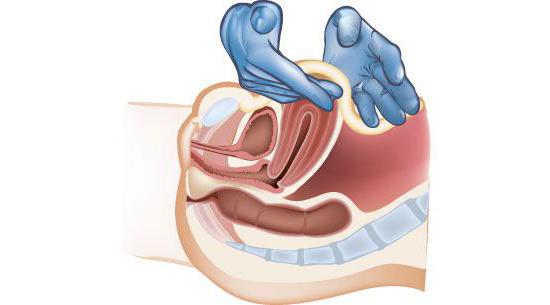
Risks
How long does lochia last after childbirth, is its duration always the same when doctors expect large blood loss? The risk of developing postpartum hemorrhage is significantly higher in the following cases:
• polyhydramnios (excessive amount of amniotic fluid);

• birth of a large baby;
• uterine fibroids, which does not allow uterine fibers to contract symmetrically;
• the mother is weakened due to anemia during pregnancy, preeclampsia or difficult long labor;
• The mother is taking herbs or drugs that prevent blood clotting, such as ibuprofen, aspirin, or other similar drugs.
When does your period start?
How many days does lochia last after childbirth? How to distinguish lochia from menstruation? When does your first period come? If you are not breastfeeding, your first period may take 1 or 2 months to arrive. But sometimes the waiting period extends to 12 weeks. If you're breastfeeding, your period may take a few weeks to arrive, although many breastfeeding moms note that your period may not come until your baby is weaned. When your first period appears, it may differ from previous prenatal regular bleeding. It may be heavier or longer than normal ones. Or it may stop suddenly and then start with clots. There may also be profuse bleeding. It is necessary to monitor your periods and the amount of blood released. If you need to change your pad more often than every hour and this continues for several hours, call your doctor.
When does your period come?
If the child is completely on breastfeeding
If the child is fully breastfed, then restoration of regulation should be expected 3 months after the cessation of lactation. The body of a nursing woman produces the hormone prolactin. It affects the deactivation of follicle-stimulating hormone (FSH), without which ovulation is impossible. So it blocks the activity of the ovaries, and if ovulation does not occur, then regulation does not occur.
Some women believe that it is impossible to get pregnant during lactation, because menstruation does not occur. This is a misconception. In fact, a nursing mother does not menstruate for a year or a year and a half, but the possibility of getting pregnant still exists, since spontaneous ovulation occurs.
On mixed or artificial nutrition
When a woman's milk production decreases, she introduces complementary foods. In this case, FSH production is activated, and after 3 months you should expect the onset of menstruation.
Duration of uterine recovery
We found out how long lochia lasts on average after a childbirth, but they come in several varieties. Their duration also depends on this.

They appear during the healing process of the inner surface of the uterus.
The active phase lasts about three weeks. During this time, several types of discharge are observed.
- Reds. It takes about 3-4 days after the baby is born. They cause discomfort to a woman because they are very abundant. The color of the discharge is bright scarlet, since the remains of non-viable tissue contain a large number of erythrocytes - red blood cells. Clots of brown blood may also be released. The discharge should end on day 4. In this case, a woman changes one pad per hour. If you have to change it more often, you need to call your doctor. After childbirth, the gynecologist usually advises the woman about how long the lochia lasts, so it is not difficult for the expectant mother to navigate.
- Serous. Lasts from 4 to 10 days and is not as abundant as red ones. The color of the discharge is pinkish-brown or brown, since a large number of leukocytes are present in the discharged substances. Usually, red clots no longer appear, and only bloody-serous discharge is observed.
- White. They do not cause discomfort to the woman and last for 20 days. Normally, the discharge should be without bloody clots or a strong odor. They are yellowish or whitish in color, almost transparent, of a smearing nature.
If after giving birth you know how long it will take for the lochia to come out, you will immediately understand when you need to contact a specialist for help. The volume of discharge begins to decrease over time, and already at week 3 it does not cause discomfort, therefore it is almost unnoticeable and very small in volume. Usually, by the 6th week, glassy mucus with bloody patches is released from the cervix, at which point the body completes its restoration. At the same time, the duration of the discharge does not depend on whether it is your first pregnancy or your second.

In case of complications, you should consult a doctor
When to see a doctor
If you know exactly when the lochia discharge should end after childbirth, it will be easier to track possible violations. You need to make an appointment with a doctor in the following cases.
- The discharge lasts too long or its amount has become quite large. Such bleeding is possible due to the fact that parts of the placenta remain in the uterus, so it cannot contract normally. In this case, the woman will have to remove the remaining placenta in the hospital. The procedure is painless due to intravenous anesthesia.
- The bleeding has stopped, although you know exactly how many days after the last birth the lochia should go. Stopping discharge indicates a possible accumulation of lochia in the uterine cavity. If they are not removed, there is a risk of developing endometritis.
Endometritis develops if, after childbirth, lochia is excreted with pus and has an unpleasant, pungent odor. A woman notices a deterioration in her health:
- lower abdomen hurts;
- the temperature rises.
In this case, you need to urgently call a specialist or call an ambulance. Sometimes a cheesy discharge appears from the vagina. This may indicate the appearance of candidiasis. If left untreated, there is a risk of developing a severe infection.
It doesn’t matter how long lochia lasts after the first or second birth. If severe bleeding occurs, you should immediately call an ambulance. In this case, the woman is indicated for hospitalization.
Only careful attention to your health, monitoring of discharge and timely response to its changes will help to avoid serious complications. It is better to play it safe and consult a doctor once again than to subsequently be treated for unpleasant sores.
What should cause concern
If, instead of decreasing, the volume of discharge suddenly increases sharply, the woman should consult a doctor, since in this case it may be a symptom of uterine bleeding. If for several hours in a row a standard pad becomes saturated with blood within 40–60 minutes, we are talking about internal bleeding.
Read also:
What are the consequences of fetal hypoxia in a child after birth and what do they depend on?
If the discharge acquires an unpleasant putrefactive odor or a yellowish-green tint, then most likely an inflammatory process develops in the internal genital organs. It may be caused by kinking of the uterine tubes and, as a result, the accumulation of lochia there.
An inflammatory process in the uterus can lead to the development of endometritis. It may be accompanied by severe pain in the lower abdomen, fever and purulent discharge. Once the diagnosis is confirmed, the doctor will definitely prescribe a course of antibacterial drugs and uterine curettage.
In addition to the factors listed above, reasons for urgently seeking medical attention are also:
- the appearance of clots and mucus;
- pain in the lower abdomen;
- increased body temperature, weakness, deterioration of health;
- The duration of discharge is more than 6–7 days.
In order for the uterus to recover quickly after the birth of the baby, doctors advise sleeping on your stomach more often, or at least resting in this position. Also, you should not walk with a full bladder; it is better to go to the toilet at the first urge.
In most cases, discharge that continues in women for a month after childbirth is a natural phenomenon and does not require any measures or treatment. However, it is during this period that problems that arose during childbirth, for example, erosive processes in the cervix or remnants of the placenta in the uterus, can make themselves felt. Therefore, the woman in labor should carefully monitor the intensity and nature of the discharge in order to notice alarming symptoms in time.
What type of discharge occurs after childbirth?
Lochia consists of blood cells, ichor, plasma, scraps of the lining of the uterus (dying epithelium) and mucus from the cervical canal, so you will notice mucus and clots in them, especially in the first days after childbirth. When pressing on the abdomen, as well as during movement, the discharge of wound contents may increase. Keep this in mind, if you want to get out of bed, you will immediately gush. Therefore, we recommend that you first place a diaper under your feet.
Lochia will constantly change its character. At first they resemble menstrual discharge, only much more abundant. This is good because the uterine cavity is being cleansed of wound contents. After just a few days, the lochia will become slightly darker in color and less in number. In the second week, the discharge will be brownish-yellow and acquire a mucous consistency, and after the third week it will be yellowish-white. But blood impurities can be observed for a whole month after childbirth - this is normal.
Reasons for missing periods
The main reasons for the delay in the onset of menstruation may be a long recovery period, the individual characteristics of the female body, and breastfeeding. Factors that may affect the absence of menstruation are:
- improper and insufficient nutrition;
- stress and nervous tension;
- severe fatigue and constant lack of sleep;
- complications after pregnancy;
- hormonal imbalance.
If you suspect a lack of menstruation on time, you should definitely consult a doctor for examination and testing.
How long do periods last after childbirth? From it you will learn about the duration of the menstrual cycle and menstruation, the reasons for long and short menstruation, what to do in case of irregularities.
When do you get your period after giving birth while breastfeeding? Read here.
It must be remembered that childbirth and pregnancy place certain stress on a woman’s body. Depending on her age and health, the recovery process takes different times. For some, menstruation after a cesarean section may begin within a month after birth (provided there is no lactation), and for some it is absent during the entire period of breastfeeding.
There are many factors that influence the recovery of the body:
- proper nutrition;
- rest of a young mother;
- lack of stress, etc.
Therefore, it is best if relatives come to the aid of a woman after a caesarean section. Still, this is an abdominal operation, during which movement is limited, the young mother is not allowed to lift heavy objects for a certain period of time, etc.
If, after the introduction of complementary foods or the complete end of breastfeeding, menstruation still does not occur, this should alert you. The cause may be serious illnesses, so do not delay the examination by a gynecologist.
To avoid bleeding?
Even after the mother has been transferred to the postpartum ward, the likelihood of bleeding still remains high. If the amount of discharge increases sharply, call a doctor immediately. To prevent bleeding, do the following:
- Turn over on your stomach regularly: this will help empty the uterine cavity of wound contents. Better yet, lie more on your stomach rather than on your back or side.
- Go to the toilet as often as possible, even if you don't feel the urge. Optimally every 2-3 hours, since a full bladder puts pressure on the uterus and prevents its contraction.
- Place a heating pad with ice on your lower abdomen several times a day: the blood vessels will contract, which also prevents bleeding.
- Do not lift anything heavy - the amount of discharge may increase with physical activity.
In addition, in nursing mothers, lochia ends much faster. Therefore, breastfeed your baby on demand - during sucking, the mother’s body produces oxytocin, which provokes contraction of the uterine muscles. At the same time, the woman feels cramping pain, and the discharge itself intensifies.
When does your period start after childbirth?
Based on the above, it is easy to guess that the onset of menstruation after childbirth depends on breastfeeding. In order for prolactin to be actively produced, a woman must breastfeed her baby at any time of the day or night (on demand). The more often the better. Only in this case your period will not come. But as soon as lactation decreases, prolactin production drops, which means that periods are restored again.
And now about the norms and deadlines. Lately, as already mentioned, there are many “normal” deadlines. This is because each woman’s body is individual, and besides, modern “technologies” (hormonal drugs for contraception, medical childbirth) sometimes violate what Mother Nature intended and established.


